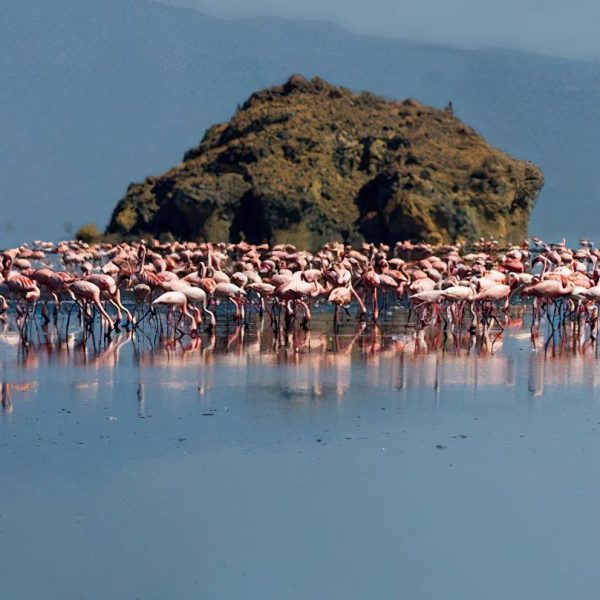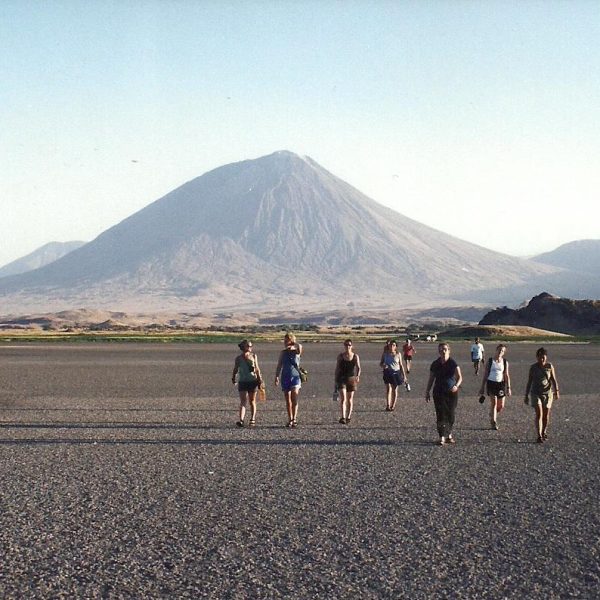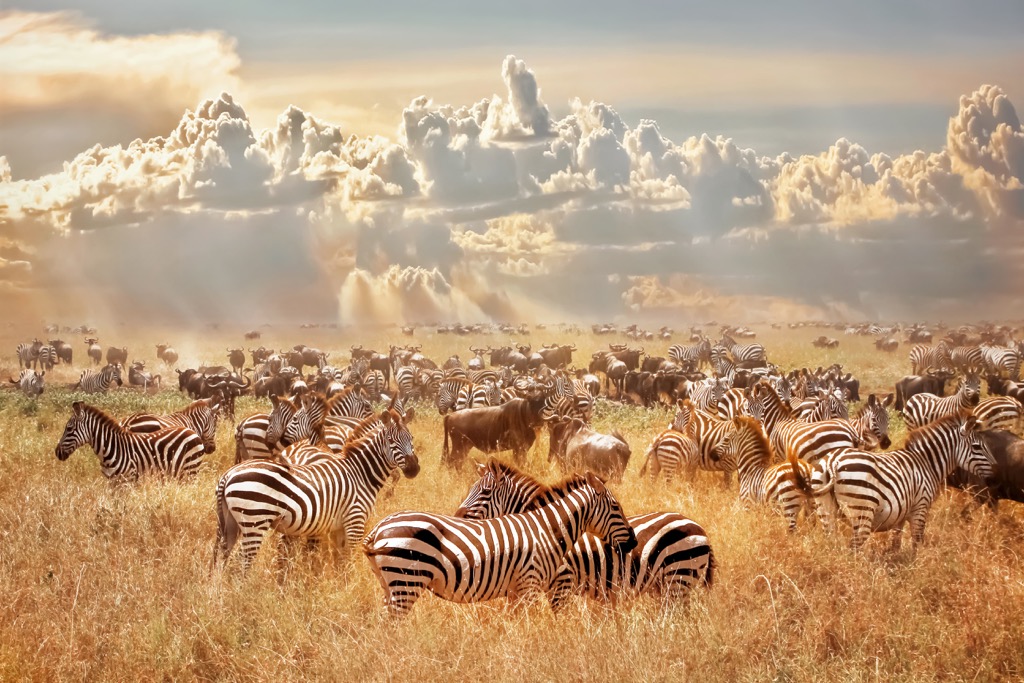Lake Natron
Tucked away in the northern reaches of Tanzania, Lake Natron is a fascinating and surreal destination that often goes unnoticed by mainstream tourism. Known for its eerie beauty and striking red hues, this alkaline lake is one of the most unusual bodies of water on Earth. Although it may seem inhospitable to some, Lake Natron is home to unique wildlife, incredible geological formations, and offers travelers an adventure like no other. Let’s dive into the wonders of Lake Natron, from its dramatic landscapes to the cultural and ecological significance that makes it a hidden gem.

Geography and Location
Lake Natron is situated in the northern part of Tanzania, near the border with Kenya, in the Eastern Rift Valley. It lies at the base of Ol Doinyo Lengai, an active volcano that dominates the landscape and contributes to the lake’s unique chemical composition. The lake’s remote location in the heart of East Africa’s Great Rift Valley makes it a haven for those looking to escape the crowds and explore a lesser-known but extraordinary part of the world.
Lake Natron is about 50 kilometers (31 miles) from Ngorongoro Crater, placing it on the northern safari circuit. It’s not far from other major attractions like the Serengeti and Tarangire, making it a perfect off-the-beaten-path destination for those seeking a more tranquil and otherworldly experience in Tanzania.
The Formation and Alkaline Nature of Lake Natron
One of the most captivating features of Lake Natron is its highly alkaline nature, with water pH levels that can range from 9 to 10.5, which makes it incredibly caustic. The lake’s unusual chemical composition results from the volcanic activity of Ol Doinyo Lengai, the only active volcano in the world that erupts natrocarbonatite lava. This lava releases sodium carbonate and other minerals into the lake, which gives it its distinctive reddish hue and high alkalinity.
The lake’s waters are so harsh that they are hostile to most forms of life. The high concentration of minerals in the water, along with the scorching heat, prevents most animals from entering the lake. However, its appearance—caused by the evaporation of water and the buildup of salt—creates a surreal, almost otherworldly landscape that draws photographers, adventure travelers, and nature lovers.
The Unique Flora and Fauna
While it may appear lifeless, Lake Natron is teeming with unique life forms, especially those that have adapted to its extreme environment.
- Microorganisms: The lake supports a range of microorganisms that thrive in the highly alkaline waters. These microorganisms, primarily algae and bacteria, give the lake its striking red and orange color, especially during the dry season when the water levels are lower. Some species of cyanobacteria, for instance, contribute to the lake’s reddish hue by thriving in the lake’s high-salt and alkaline conditions.
- Fish: Despite the lake’s harsh conditions, some species of fish, such as the Alkaline tilapia, have adapted to the high salinity and pH levels. These fish are highly resilient and form an important part of the ecosystem.
- Salt-Tolerant Plants: Around the lake, salt-tolerant vegetation like Tamarix and various types of grasses and shrubs grow along the margins, where they are shielded from the lake’s most extreme areas.
The Flamingos of Lake Natron

Lake Natron is one of the few breeding grounds for the lesser flamingo, a species known for its vibrant pink and red plumage. The lake provides a crucial habitat for these birds, who flock to the area in large numbers to nest on the salt flats around the lake. The flamingos rely on the lake’s saline and alkaline waters to feed on the abundant algae and microorganisms that thrive in the harsh environment.
The flamingo population around Lake Natron is especially significant because this is one of the few places on Earth where the lesser flamingos can safely breed. The lake’s inhospitable waters keep most predators at bay, providing a relatively safe sanctuary for the flamingos. Visitors can witness the breathtaking sight of thousands of flamingos flocking to the lake’s shores during the breeding season, making it an unforgettable wildlife spectacle.
Attractions and Activities Around Lake Natron
Though Lake Natron is often seen as an extreme and desolate location, there are several intriguing attractions and activities that draw adventurers to this part of Tanzania.
The Ngare Sero Waterfall
Not far from Lake Natron, the Ngare Sero Waterfall offers a refreshing and contrasting landscape to the harsh environment of the lake. This hidden gem is tucked away in a lush canyon surrounded by verdant forests. The cool, clear waters of the waterfall provide a stark contrast to the surrounding arid landscapes and are perfect for a refreshing swim after a day of exploring. Hiking to the waterfall also offers an opportunity to witness the local flora and fauna, including birds and small mammals.
The Geysers of Lake Natron
Another fascinating feature near Lake Natron is its natural geysers. These hot springs and geothermal features spew steam and warm water, adding to the mystical allure of the area. The natron geysers are visually striking and contribute to the mineral-rich environment surrounding the lake.
Best Time to Visit
The best time to visit Lake Natron is during the dry season, which runs from June to October. During this period, the water levels of the lake are lower, and the colors of the lake are more intense, making for great photography. It is also the best time for birdwatching, as thousands of flamingos gather on the lake’s shores.
The wet season, from November to April, brings cooler temperatures but also higher water levels. While the landscape may not be as vivid, the influx of migratory birds and wildlife offers a different experience for nature enthusiasts.
How to Get There
Lake Natron is accessible by road from Arusha (about a 5-6 hour drive) and can be reached by 4×4 vehicles. The road conditions can be challenging, especially during the rainy season, so it’s advisable to travel with a guide or a local operator who knows the best routes.
Alternatively, visitors can combine a trip to Lake Natron with a safari in the nearby Serengeti or Ngorongoro Crater. Some tour operators offer extended safari packages that include visits to Lake Natron.
Travel Tips for Lake Natron

- Prepare for the heat: The climate around Lake Natron can be extremely hot, especially during the dry season, so pack plenty of water, sunscreen, and light clothing.
- Stay hydrated: Given the dry and arid conditions, always keep water on hand to stay hydrated during your visit.
- Be cautious around the lake: Due to the lake’s highly alkaline waters, avoid direct contact with the water, as it can cause skin irritation. Take caution when walking along the shore.
- Respect the environment: Lake Natron is a fragile ecosystem, so it’s important to be mindful of your environmental impact and avoid disturbing the local wildlife, especially the flamingos.
Conservation Efforts
Lake Natron is a key ecological site, and several conservation efforts are in place to protect the region’s unique environment and wildlife. The area around the lake is part of the Lake Natron Basin and is managed by conservation groups such as the Flamingo Conservation Group. These organizations work to protect the flamingo breeding grounds and ensure the health of the lake’s ecosystem while supporting sustainable tourism.
Why Visit Lake Natron?
Lake Natron is one of Tanzania’s most striking natural features, offering a dramatic landscape of red-tinted waters, salt flats, and volcanic hills. Despite its remote location and inhospitable conditions, the lake is teeming with life, from flamingos to hardy microorganisms. Whether you’re an adventure traveler, a photographer, or a nature enthusiast, Lake Natron promises an unforgettable and off-the-beaten-path experience in one of Africa’s most awe-inspiring environments.
Why Visit Tanzania?

Tanzania is home to some of the world’s most iconic destinations, including:
- Serengeti National Park: Known for the Great Migration and incredible wildlife.
- Ngorongoro Crater: A UNESCO World Heritage site and one of the best places to see the Big Five.
- Mount Kilimanjaro: The highest peak in Africa, offering various trekking routes.
- Zanzibar: A tropical island paradise with pristine beaches and rich history.
No matter when you visit, Tanzania offers unparalleled opportunities for adventure, nature, and culture.
Best Time to Visit Tanzania

The best time to visit Tanzania depends on your experience preferences. For wildlife safaris, the dry season from June to October offers the best game viewing, while January to February is ideal for the Great Migration calving season in the Serengeti. If you’re climbing Mount Kilimanjaro, the best months are January to March and June to October for clear skies. Zanzibar’s beaches are perfect from June to October and December to February. Avoid the long rains (March to May) when some lodges close, though the landscape is lush and less crowded.
Understanding Tanzania's Seasons

Tanzania has two primary seasons: the dry season and the wet season. The timing of your trip will depend on your preferred activities, whether you want to enjoy wildlife safaris, beach vacations, or mountain trekking.
Dry Season (June to October): Best for Safaris and Wildlife Viewing
The dry season in Tanzania typically lasts from June to October. This is the most popular time for safaris, as it coincides with excellent wildlife viewing conditions. The dry season is ideal for those interested in seeing large game, including the Big Five.
- Weather: Warm and sunny, with temperatures ranging from 25°C (77°F) to 30°C (86°F). Nights are cooler, especially in higher altitudes like the Ngorongoro Crater.
- Wildlife: During this period, animals congregate around waterholes, and vegetation is sparse, making wildlife easier to spot. This is also the time to witness the Great Migration in the Serengeti, especially from July to October, when thousands of wildebeest cross the Mara River.
- Why Visit: Ideal for a safari experience with clear skies, fewer mosquitoes, and the best chance of seeing a variety of wildlife.
Wet Season (March to May): Best for Lush Landscapes and Fewer Crowds
The wet season in Tanzania occurs from March to May. While the rain can make certain roads impassable, the wet season also offers a unique and quieter experience for those willing to brave the conditions.
- Weather: Expect heavy rainfall, especially in April and May, with temperatures ranging from 23°C (73°F) to 28°C (82°F). Rain showers are usually short but intense.
- Wildlife: The wet season is not the best for wildlife viewing, as animals spread out across the park in search of food. However, the lush greenery makes the landscapes incredibly beautiful, and birdwatching is at its peak.
- Why Visit: Ideal for visitors looking to avoid the crowds and enjoy a more serene, peaceful experience. This is also a great time to visit the beaches of Zanzibar, where the rainfall is less intense compared to mainland Tanzania.
Shoulder Seasons (January to February): Best for Calving Season and Mild Weather
The shoulder months of January and February are between the wet and dry seasons. These months offer mild weather and excellent opportunities to see the wildebeest calving season in the Serengeti.
- Weather: Warm but not too hot, with temperatures around 24°C (75°F) to 30°C (86°F). There is less rain compared to the wet season, making it a great time for outdoor activities.
- Wildlife: January and February are prime months to witness the Great Migration’s calving season in the southern Serengeti. This is a thrilling time for wildlife enthusiasts, as you’ll see thousands of wildebeest give birth, attracting predators like lions and cheetahs.
- Why Visit: Perfect for those looking to witness one of nature’s most incredible events—the birth of wildebeest calves—and enjoy pleasant weather for trekking and other activities.
The Best Time to Visit Tanzania Based on Activities

Safari in Serengeti and Ngorongoro Crater
- Best Time: June to October (dry season)
- Why: This is when the animals are easier to spot due to the dry conditions and fewer places to hide. It also coincides with the Great Migration in the Serengeti, which is a once-in-a-lifetime experience.
Climbing Mount Kilimanjaro
- Best Time: June to October (dry season) and January to February (shoulder season)
- Why: The weather is clearer during the dry season, providing better trekking conditions. If you’re planning to summit Kilimanjaro, these months offer the least amount of rain and the best visibility.
Zanzibar Beach Holiday
- Best Time: June to October (dry season) and December to February (shoulder season)
- Why: The dry season provides the most pleasant conditions for lounging on Zanzibar’s beautiful beaches. December to February is also a good time if you want to avoid the peak season crowds but still enjoy sunny weather.
Accommodation Options in Tanzania

Tanzania offers a wide range of accommodations to suit different budgets, from luxurious lodges in the Serengeti to more affordable campsites in Ngorongoro.
- Luxury: Four Seasons Safari Lodge Serengeti, Ngorongoro Crater Lodge
- Mid-Range: Serengeti Serena Safari Lodge, Ngorongoro Sopa Lodge
- Budget: Mbugani Tented Camp, Simba Campsite


